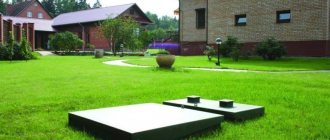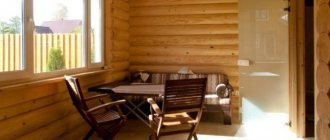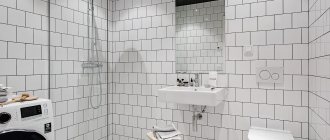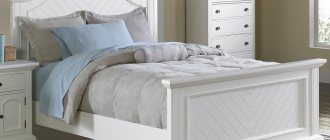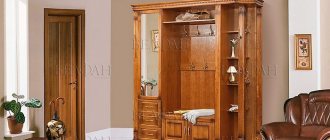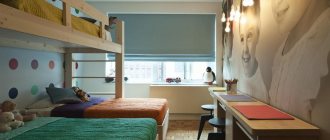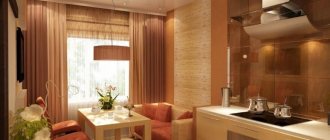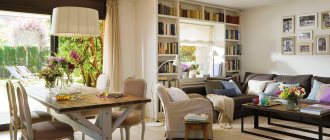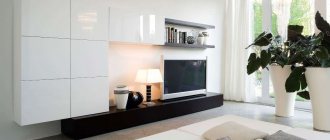Buying a private house with a plot of land is a joyful event, a new stage in a person’s life. Along with this joy, the homeowner also finds pleasant chores, because a private house needs decoration and organization of space, and the garden plot needs to be improved and the creation of a modern landscape design. Unfortunately, the shape of the plot can be any and the homeowner does not always get what he wanted. If the territory has non-standard shapes, for example, long and narrow, then these shortcomings can be corrected and the advantages of the site can be emphasized by competently creating a landscape design. How to do it? Find out about it with us.
Advantages and disadvantages of a narrow section
A piece of land less than 15 meters wide is not a very successful, but very common layout, which has its pros and cons.
Positive sides:
- lower cost than a square plot of land;
- convenient zoning of space. Example: on one side there is a garden and vegetable garden, in the middle there is a house, behind it there is a garage and outbuildings;
- the design of a house with a smaller width includes large attic windows;
- a single-flight ladder along the wall will originally complement the facade, decorating it;
- If you decide to set up a vegetable garden, it’s easy to make it inconspicuous.
Negative points:
- it is problematic to accommodate a wide, square house, and a very narrow one will have to be well insulated, since it freezes more strongly;
- neighboring houses are located too close, they can shade part of the site, a lower building;
- difficulties with placing a garage - close to the house it will disrupt the composition of the yard, and if located far away, the road to it will take up a lot of usable space;
- a narrow garden in which it is impossible to plant trees that are too tall - they will shade the garden;
- when the site is located near the road, problems with high-quality sound insulation are possible.
To keep the house from being completely cramped, small-width furniture is used, as well as built-in furniture.
Decorative gates
The part of the garden between the wall of the house and the fence can be separated from the main area with an additional gate. They are usually made of wood, may not be transparent, or consist of decorative grilles. These side gates are tall enough to provide privacy, but warm wood colors will make the structure look welcoming.
Behind them you can create an intimate relaxation area, hidden from prying eyes. In addition, if there are small children in the family, objects that are dangerous for children can be placed behind the gate in this part of the garden. Poultry lovers can set up a small poultry yard outside the gate.
Features of planning and zoning
It is recommended to divide a narrow land plot into three main zones:
- residential is a place for a home, a children’s or sports ground, a swimming pool;
- garden - here they set up a vegetable garden and a garden;
- household - here they build a shed for tools or keeping animals, a garage, a shower with toilet, etc.
The house is located along or across the dacha plot - as it will be more convenient for those living or vacationing in it. Communications - electricity, heating, gas supply, water supply, sewerage are designed in advance, based on the location of the home and other buildings.
Even if the land is completely fenced with a solid stone fence, a more elegant design is made near the entrance - wrought-iron grilles, perforated wooden gates, etc.
Location of the house
The main element of the plan is a residential building, the location of which usually begins with determination. The ideal orientation of the ends is west-east, so the building will receive a lot of daylight, warming up well in the sun. When the landholding is tiny, occupying a couple of acres, the building is built along the entire plot, the exit is made directly from the rooms. In a “carriage” type house, the rooms, except for the end ones, will be walk-through. It is undesirable to make a building less than five to six meters wide - this is very inconvenient for life. The building is often made two-story or with attics, and a sauna, gym or cellar is equipped in the basement.
Zoning of the site
When zoning, you should make the most of every corner of the plot - even the most non-functional, one with complex terrain, etc. On a large landholding it is easy to place both main and additional, optional zones, but if the plot is very small, then you will have to give up a lot or something combine with something. It is recommended to place the garden with a vegetable garden on the sunny side, while the barn, garage, toilet, and animal premises should be located in the shade.
Mandatory zones
The following areas are mandatory:
- representative or front zone - located near the entrance to the home. There are alpine slides and fountains, vertical and ordinary flower beds, preferably asymmetrical. This is the “face” of land ownership, therefore very careful care is required for the front area;
- private zone - separated from the previous one by trellises and pergolas, curtains and a low fence. These structures in an elongated area are made low, when the zones are separated with the help of flowering plants; white-yellow, pink, and light blue shades are preferred. Inside the private corner there is a gazebo, a terrace, a green office, and a hammock;
- a specialized or economic zone is fenced off just like everyone else. Here they place sheds for equipment, enclosures for animals, hang clotheslines, etc.;
- transit or buffer - arranged if necessary, located closer to the exit from the site, but not in the middle. Here they park a car, motorcycle, bicycle, install water and light meters so as not to let strangers into the house. Also, if necessary, brought construction materials are unloaded here. The buffer is separated from the rest of the space by a taller hedge, wooden or brick fence.
Optional zones
Optional ones include:
- sports ground - most often it is placed between a specialized area and a recreation area;
- children's playground - set up next to the place where adults relax, separated by a symbolic flowerbed or path so that children are always in sight;
- vegetable garden - usually adjacent to the economic zone, separated from it by a hedge or a miniature fence.
Minuses
If we talk about disadvantages, such plots, of course, have them, among them:
- Inability to build your dream home. The narrow dimensions of the plot do not always allow you to build exactly the house you wanted.
- Lack of tall trees. In narrow areas, regardless of their length, you will have to abandon large trees, since their crown will shade the area and visually make it even smaller.
- Inability to isolate yourself from neighbors and the road. It is not recommended to install a blind fence around the perimeter of a narrow area.
- Additional expenses for arrangement. Narrow areas are considered difficult to work with. Without skills or special education, it is unlikely that you will be able to improve the territory. Therefore, you will have to hire professional landscape designers.
Stylistic directions for a narrow area
The style of the landscape depends on the area of land ownership, the personal preferences of its owners, the most popular:
- minimalism - there are very few details, which is convenient for small plots. The buildings are only necessary; instead of lush flower beds and trees, there are neatly trimmed lawns and bushes. Volumetric embankments, smooth paths, straight trellises for climbing plants are allowed;
- hi-tech - a lot of metal, glass, mirror elements. Gray steel fence and chrome furniture in the sitting area, mirror. Repeating the outline of a small pond, framing the flower beds with borders painted with silver paint;
- eastern - low bushes and trees, alpine slides with many stones and pagoda gazebos. Smooth lines, rounded ponds, ornamental plants from China and Japan, and low wicker furniture are welcome. Symmetry and right angles are completely absent;
- English - perennial plants of different heights predominate here, winding paths paved with coarse gravel or tiles. Reservoirs, practically indistinguishable from those found in the wild, are organically combined with flower beds and carpets;
- country - the beds are located almost chaotically, pumpkins and peppers grow in the flowerbeds, and flowers - wherever necessary. Stylized crane wells, wooden wheels and carts, and fragments of fences woven from wicker are used as decoration;
- Baroque - suitable only for spacious areas. Lush rose bushes and openwork gazebos with columns, antique sculptures and decorative fountains. Forged garden furniture and gilded elements create the most luxurious design;
- forest - only natural materials are used, forest trees, mossy stones. Wooden buildings and beds are made inconspicuous. The land tenure resembles a plot of real forest, with small accents - the redevelopment here is very minimal.
Tips for choosing a style
The problem with a narrow long area is that its arrangement needs to be approached competently, otherwise the area can simply be reloaded. Therefore, it is recommended to seek the help of specialists.
When choosing a design for such an area, it is recommended to choose discreet styles that do not contain clutter of decorative elements.
Minimalism
The style is simple and concise. The peculiarity of minimalism is geometrically correct forms. You can use installations made of wire and mirrors in your design. The main color is green. It is complemented by light shades: white, beige, light pink, gray. You can make a bright color accent, but the main thing is not to overdo it.
Using this style, it is difficult to visually expand the space. Despite this, minimalism is often used when improving suburban areas.
Japanese style
The essence of this style is asymmetry. For visually expanding a narrow area, the Japanese style is most suitable. A Japanese-style garden always includes stones, plants, and water. The water problem can be solved by constructing a simulated stream. All you need is gravel and pebbles.
As for plants, there should be a lot of them and they should be everywhere. The asymmetry of the Japanese style means that both low varieties of plants and high varieties of flowers and shrubs can be planted nearby.
Eco style
Its peculiarity is naturalness. An eco-style garden should seem like a space untouched by humans. Depending on climatic conditions, almost any idea can be brought to life in eco style.
It is almost impossible to arrange an area in eco-style on your own, since you need to know exactly which plants can grow together in the wild and which cannot. When arranging gazebos, benches, and paths, you must remember that they all must be made of natural materials.
Alpine style
This option is perfect for areas with uneven terrain. The emphasis in the alpine style is on the stones. Paths are laid out of this material and gazebos are built. It is better to combine shrubs and low coniferous trees with stones. There should be few flowers.
The advantage of the alpine style is that maintenance of an area made in this style is minimal.
Country
The rustic design style is very popular among lovers of country life. The characteristic features of country style are simplicity, lightness, and some randomness. Rustic style involves the use of wooden furniture, wicker baskets and similar decorative items. Clay pots and various figurines will fit perfectly into the country style.
For garden lovers, the rustic style is an outlet. The style assumes the presence of fruit trees and vegetable beds. Even flower beds can be laid out not with flowers, but with vegetables. They will fit well into the design of beds with spicy and medicinal plants.
As for flowers, there is no need to give them up. It’s just that you don’t need to allocate separate flower beds for them; you can plant flowering plants in free space.
If the site is very long, then you can take a walk and consider other styles, for example, high-tech, Mediterranean, exotic.
Methods of visual correction
To correct a narrow, elongated space, you need to divert attention from its configuration and size. Tall trees here are planted in transverse rows or grouped at the very end of the garden, near the narrow sides. Closer to the middle there are low trees and shrubs. It is advisable to do zoning not along, but across, with the help of hedges, paths, vertical flower beds, and garden sculptures. Smooth rows must be combined with smooth, rounded lines; it is advisable to avoid high fences altogether.
Several large mirrors, located slightly at an angle on the long sides, can visually expand the land ownership. At night, the area is brightly illuminated along the long sides, while the short sides are dimly illuminated or not illuminated at all. Brightly flowering plants can also expand space.
How to adjust space
This is the next question that comes up sharply after drawing up a zoning plan for a narrow area. There are a lot of visual correction techniques. Which of them is rational to use in our case?
First of all, try to use every inch of the space, including seemingly non-functional corners and the deepest corners. The main thing is not to repeat the chronic mistakes of narrow section design. For example, do not plant tall trees around the perimeter. Their height will only aggravate the situation and present the territory as even more elongated and disproportionate than it actually is.
Do not plant tall trees around the perimeter of the plot
The right effect will be achieved by planting this type of vegetation at the very end of the territory, along the short side. In the design of a long plot, bring low-growing subspecies of shrubs and fruit-bearing trees to the foreground. This is a great way to open up a space and give it a domesticated, lived-in feel.
Low-growing shrubs will make the area wider
You may not strive to maintain the visual integrity of the plot. A torn picture will also distract from the shortcomings of the land layout. In the design of an elongated site, follow a policy of clear zonal division of areas with an emphasis on highlighting the boundaries of functional parts. To do this, feel free to involve all kinds of architectural forms in the project, from symbolic fences to luxurious pergolas and arches. These elements will help shade the real boundaries of the object.
Emphasizing the boundaries of functional parts
Experts recommend trying to zoning a narrow area in another way. Divide it into several parts so that you can later fill them with sand, pebbles or sow them with grass. This approach is justified if the zones are not planned to be separated by solid fences and the entire territory remains visible.
In the design of a narrow area, you cannot use geometrically clear lines. This means that alleys and paths need to be made cleverly winding, meandering randomly among the trees. If you plan to lay the paths with tiles, then lay it in some kind of pattern, perhaps even ornamental.
Smooth lines will visually expand the boundaries of the site
Similar tactics must be followed when decorating flower beds in a narrow area. Flower beds are also given irregular shapes. In this case, the courtyard area seems wider, the garden – more voluminous.
An excellent counterbalance to the elongated shape of the allotment will be green spaces with spherical crowns.
A painful issue in the design of a long plot is the fence. If giving it up completely is unrealistic, then make it low, ideally multi-level and multi-colored. Low-growing weaving plantings can serve as additional decoration.
Decorate the fence with climbing plants
In the struggle to expand the site, it is permissible to use transverse lines. They can be depicted in borders, flower beds, or a strip of green hedge.
The transverse design will bring balance to the perception of the elongated territory.
Cross zoning brings balance
Bringing distant areas closer
If you did not get a virgin plot of land, but it was already inhabited by someone else, then perhaps for the successful design of a narrow plot you will also need to use techniques for visually zooming in/out of objects. For example, at the end of the garden there is a tall, beautiful tree, which is extremely frustrating to cut down. Use it for practical purposes. Plant another one diagonally from it, but only a smaller tree. This step will visually shorten the space. A good way to bring the remote part of the area closer is to include in the design of the elongated area a small gazebo, which, surrounded by flowers, will spread out in the backyard. If you don’t want to build a gazebo, put a fountain there or build a multi-tiered flower bed.
The gazebo will bring the remote part of the site closer
When designing a narrow area, you will need to focus on at least three objects. These could be: garden sculptures, decorative arches, secret gates. The background of the territory is designed brightly and colorfully, while near the entrance everything should look restrained. A cold palette is more appropriate here.
Bright flowers will visually expand the area
In the corrective design of the shape of a narrow area, green spaces are actively used. So, to visually expand the area, tree-like plants with large, bright yellow leaves or plants that bloom in yellow-orange are planted in the garden part.
Small architectural forms, decor
The decor is selected based on the style of the landscape. It is made of wood, ceramics, stone, concrete, plastic, rattan, wire, etc.
What does this include:
- benches;
- garden lights;
- decorative wells;
- miniature fountains;
- sculptural compositions;
- swing;
- doghouse;
- birdhouse;
- flower pots;
- arches;
- bridges;
- forged trellises;
- flowerpot;
- urns.
Many amateurs create decor on their own, from scrap materials - old tires, plastic bottles, driftwood, stones, fragments of old furniture and household appliances. The children's playground, in addition to ladders and swings, is decorated with colored garden gnomes, ducklings, frogs, mushrooms, the paths are sprinkled with colored stone chips and gravel. The place intended for relaxation is decorated with an artificial pond with a waterfall, a bridge, and a grill or barbecue with suitable furniture is placed on the terrace. Weather vanes, signs, and mailboxes will complement the space at the front entrance in an original way.
Create a border with container plants
If the side yard is very narrow and has solid paving, it will be very difficult to create a flower garden there. Container gardening will help. You can improve this part of the yard with a row of potted plants placed along the fence or wall of the house.
There are not many annual plants growing in partial shade, but they still exist. First of all, these are balsams and begonias. You can diversify the compositions of these flowers by adding small shade-tolerant perennials to their company - dwarf hostas, ferns, loosestrife, jasmine and others.
Design of a multi-level area
A plot of land with a slight slope and a couple of hills is not at all uncommon. It is recommended to build a house on such a site in the highest place. The space is leveled as much as possible, or left virtually unchanged. Landscaping begins with drawing up a project in which all the elements are linked together, since the more relief the terrain, the more noticeable minor errors are.
But there are undoubted advantages: if everything is done correctly, using competent geoplastics, each unevenness will become a kind of highlight of land ownership, and the cost of such “inconvenient” plots is much lower than ordinary ones. Difficulties arise with arranging a garden: it is important to know which plants love water, which are accustomed to drier soil - the latter are then planted in high places. Individual zones are separated by borders made of stone, logs, and boards, forming many tiers.
When the slopes are very steep, they are strengthened by planting trees and shrubs with powerful root systems. Each level is additionally “supported” by low fences made of stone, concrete, and brick. It is important to carefully consider the location of utilities, the location of heavy structures, paths, stairs, and drainage systems. It is advisable to design the area taking into account the movement of the sun - so that the garden is not shaded, private corners and recreation areas have a slight shade even at noon.
Add a step-by-step track
If your side yard is more like a backyard that gets a lot of use, then support this feature. For example, if grass grows there, to reduce wear and tear on the grass, you can install a step path in this place.
To do this, you need to purchase natural flagstone and lay out layers of stones at a short distance from each other so that each step falls on a stone. Concrete slabs can also be used instead of natural stone. The step-by-step path is not only functional, but also looks very impressive.
Side yard step path. © The Ofy
Create a shady flower bed
A paved or concreted side yard is certainly convenient, but still such a solution is a bit heavy and bears little resemblance to a garden. Use decorative plants to give a space a feeling of warmth, coziness and dimension. Since this area is sandwiched between the house and the fence, and often your neighbor's house, the side yard probably gets little sunlight. The best choices for lush flower beds in this location are plants that thrive in low light conditions.
Various ferns, hostas, sedges, hakonechloa, buzulniki and many other plants will grow well here. All these perennials have many varieties, including dwarf ones, so they will not take up much space. With their help you can create contrasting color and texture and add mood.
The best choices for side yard flower beds are plants that do well in low light conditions. © JuniperHillFarm
Tool shed
There is nothing more unsightly than equipment haphazardly scattered around the garden. In addition, this is very inconvenient, because the necessary tools should always be at hand in a certain place. In the side yard you can create a neat place to store garden tools, hidden from view.
You can create a neat storage area for gardening tools in your side yard. © Awesome Decors
Very long house
In this project, the house has a minimum width of only 5 m. Its length is 21.6 m. The project is an interesting solution for construction on a small plot of land. It includes ease of construction and attractive architectural forms. Since the project is highly functional, it should be considered in detail.
The structure is similar to the previous one. The difference between them is the location of one of the bedrooms. This room is located on the first floor. The remaining living quarters are moved to the second one. There is also a bathroom here.
Such designs of two-story houses for narrow plots are the most convenient and attractive.
Ground covers between tile joints
More impressive paving than a concrete path, but less expensive to maintain than a regular section of lawn - a stone path bordered by a cover of low-growing perennials. This would be an excellent choice for a side yard. When choosing a ground cover, look for species that will tolerate foot traffic and grow thick enough to block weeds.
Most often, the following are planted in the joints between path tiles: loosestrife, bryozoan, sedum, saxifrage, hernia grass, mazus and others. When choosing plants, be sure to consider the light level.
Rules and regulations for the location of buildings
Before building a house, it is necessary to familiarize yourself in advance with the rules and SNiPs regulating the rules for the location of buildings on a certain site.
House
When building a residential building, you need to know that:
- the minimum distance from the building to the neighbor’s fence is 3 meters;
- the distance from the house to the red line of the street is 5 meters;
- the minimum distance from the house to the road is 3 meters;
- The roof on the roof of the house must be arranged in such a way that water and snow do not fall into the neighbor’s territory when they fall.
Garage
A garage is considered an outbuilding, so it is subject to requirements similar to all outbuildings, namely:
- The minimum distance from the boundary is 1 meter;
- The distance from your neighbor's house to your garage is 6 meters.
The garage should be located in such a place that snow and water from its roof do not fall onto the adjacent area.
Detailed information about the construction of garages is here.
Bath
Like any outbuilding, the bathhouse must meet certain requirements:
- minimum distance from the road line – 5 meters;
- distance from the neighbor’s house – 6 meters;
- boundary distance – 1 meter.
Pool for dogs
If you have a pet, then you might want to think about him. It's very easy to create a swimming pool in your side yard, suitable for dogs who like to cool off in the heat. The main thing is that it is safe and easy to wash. For these purposes, it is better to choose a durable children's pool made of molded plastic, rather than an inflatable one, which is too easily pierced by a dog's sharp claws. Make sure the pool is shallow enough for your pet to get in and out of it easily.
